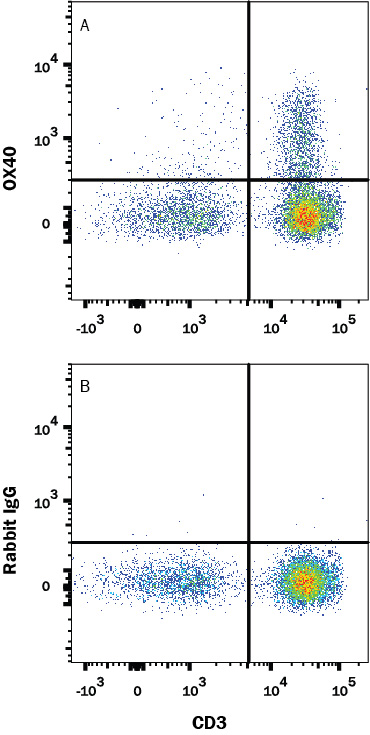Human OX40/TNFRSF4 Antibody Summary
Leu29-Ala216
Accession # P43489
Applications
Please Note: Optimal dilutions should be determined by each laboratory for each application. General Protocols are available in the Technical Information section on our website.
Scientific Data
 View Larger
View Larger
Detection of OX40/TNFRSF4 in Human PBMCs by Flow Cytometry. Human peripheral blood mononuclear cells (PBMCs) were stained with Mouse Anti-Human CD3 epsilon PE-conjugated Monoclonal Antibody (Catalog # FAB100P) and either (A) Rabit Anti-Human OX40/TNFRSF4 Monoclonal Antibody (Catalog # MAB10545) or (B) Rabbit IgG Isotype Control (Catalog # MAB1050) followed by APC-conjugated Anti-Rabbit IgG Secondary Antibody (Catalog # F0111). View our protocol for Staining Membrane-associated Proteins.
Reconstitution Calculator
Preparation and Storage
- 12 months from date of receipt, -20 to -70 °C as supplied.
- 1 month, 2 to 8 °C under sterile conditions after reconstitution.
- 6 months, -20 to -70 °C under sterile conditions after reconstitution.
Background: OX40/TNFRSF4
OX40 (CD134; TNFRSF4) is a T cell co-stimulatory molecule of the TNF receptor superfamily that coordinates with other co-stimulators (CD28, CD40, CD30, CD27 and 4-1BB) to manage the activation of the immune response (1-3). Human OX40 is a 48 kDa type I transmembrane glycoprotein with a 28 amino acid (aa) signal sequence, a 185 aa extracellular domain (ECD) that contains a cysteine-rich region, a 20 aa transmembrane segment, and a 41 aa cytoplasmic domain (4). The ECD of human OX40 shares 63% sequence identity with the ECD of mouse and rat OX40. OX40 is up-regulated on CD4+ and CD8+ T cells upon engagement of the TCR by antigen presenting cells along with co-stimulation by CD40-CD40 Ligand and CD28-B7 (5, 6). OX40 Ligand is primarily expressed on antigen presenting cells (5). OX40 Ligand engagement of OX40 on activated CD4+ T cells results in increased T cell survival, proliferation, and cytokine production. It also inhibits the conversion of effector T cells into immunosuppressive regulatory T cells (Tregs) and can promote the maintenance of and recall response in memory T cells (3, 7-10). OX40 is constitutively expressed on Tregs and enhances the sensitivity of Tregs to IL-2, thus promoting Treg proliferation. OX40 has also been shown to decrease the cells’ immunosuppressive activity on effector T cells (11-14). OX40-OX40 Ligand signaling is involved in allergic airway inflammation, graft-versus-host disease and autoimmune disease (6, 15, 16). Mutations in OX40 and OX40 Ligand are associated with cardiovascular disease (17, 18).
- Hori, T. (2006) Int. J. Hematol. 83:17.
- Latza, U. et al. (1994) Eur. J. Immunol. 24:677.
- Salek-Ardakani, S. et al. (2003) J. Exp. Med. 198:315.
- al-Shamkhani, A. et al. (1996) Eur. J. Immunol. 26:1695.
- Moran, A.E. et al. (2013) Curr. Opin. Immunol. 25:230.
- Gramaglia, I. et al. (1998) J. Immunol. 161:6510.
- Xiao, X. et al. (2008) J. Immunol. 181:3193.
- So, T. and M. Croft (2007) J. Immunol. 179:1427.
- Mousavi, S.F. et al. (2008) J. Immunol. 181:5990.
- Bansal-Pakala, P. et al. (2001) Nat. Med. 7:907.
- Piconese, S. et al. (2010) Eur. J. Immunol. 40:2902.
- Griseri, T. et al. (2010) J. Exp. Med. 207:699.
- Xiao, X. et al. (2012) J. Immunol. 188:892.
- Vu, M.D. et al. (2007) Blood 110:2501.
- Damayanti, T. et al. (2010) Am. J. Respir. Crit. Care Med. 181:688.
- Xiao, X. et al. (2012) Nat. Immunol. 13:981.
- Nakano, M. et al. (2010) Cardiovasc. Res. 88:539.
- Ishii, N. et al. (2010) Adv. Immunol. 105:63.
- Godfrey, W.R. et al. (1994) J. Exp. Med. 180:757
Product Datasheets
FAQs
No product specific FAQs exist for this product, however you may
View all Antibody FAQsReviews for Human OX40/TNFRSF4 Antibody
There are currently no reviews for this product. Be the first to review Human OX40/TNFRSF4 Antibody and earn rewards!
Have you used Human OX40/TNFRSF4 Antibody?
Submit a review and receive an Amazon gift card.
$25/€18/£15/$25CAN/¥75 Yuan/¥2500 Yen for a review with an image
$10/€7/£6/$10 CAD/¥70 Yuan/¥1110 Yen for a review without an image



